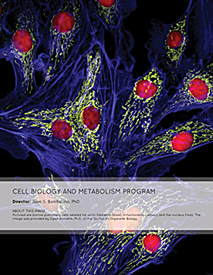You are here: Home > Cell Biology and Metabolism Program
Cell Biology and Metabolism Program
Director: Juan S. Bonifacino, PhD
Website: cbmp.nichd.nih.gov
The Cell Biology and Metabolism Program (CBMP) conducts studies in various areas of molecular cell biology, including the mechanisms of intracellular protein traffic and organelle biogenesis, host-pathogen interactions, the adaptive responses to environmental stresses, the biology of small non-coding RNAs and small proteins, regulation of the cell cycle during oogenesis, and liver cell physiology. A salient feature of the CBMP is its outstanding capabilities in state-of-the-art fluorescence microscopy techniques, including imaging of cells in real time, fluorescence resonance energy transfer, and fluorescence correlation spectroscopy. The CBMP's imaging capabilities have been greatly enhanced with the development of photoactivated localization microscopy (PALM). In addition, the CBMP maintains facilities for working with many model organisms, including bacteria, yeast, Drosophila, mice, and mammalian cells. The knowledge gained from the study of basic cellular processes is applied to the elucidation of the causes of human diseases, including disorders of protein traffic and bile acid secretion as well as neurodegeneration and microbial pathogenesis.
The Unit on Cell Polarity, headed by Irwin Arias, focuses on mechanisms and regulation of polarization mainly in hepatocytes. Live-cell fluorescent imaging, biochemical, genetic, and molecular techniques are applied to studies of long-term non-dividing cultures of mammalian hepatocytes that retain mRNA expression and structural and functional profiles. These investigations revealed distinct intracellular pathways for trafficking of apical membrane transporter proteins. The relation of these processes to AMP and LKB kinases and the kinases' activation by bile acids are being investigated particularly with regard to tight junction formation, cytoskeletal organization, and apical recycling of ATP-binding cassette transporters. The Unit's goal is to identify components and regulation of these traffic processes, their role in creating and maintaining cellular polarity, and the molecular defects responsible for heritable and acquired bile secretory failure (cholestasis).
The Section on Intracellular Protein Trafficking, led by Juan Bonifacino, focuses on the molecular machinery involved in protein sorting to endosomes, lysosomes, and related organelles. Research over the past year shed light on the mechanisms used by the human immunodeficiency virus-1 (HIV-1) to downregulate expression of the CD4 co-receptor from the surface of the host cells. In addition, the AP-4 complex was shown to play a role in the traffic and processing of the Alzheimer's disease amyloid precursor protein. Other studies revealed important aspects of the function of the retromer and GARP complexes in protein trafficking between endosomes and the Golgi complex and in lysosome biogenesis.
The Protein Biogenesis Section, led by Ramanujan Hegde, continues its work on the traffic of newly synthesized secretory and membrane proteins, investigating how these proteins are normally made and the consequences when their biogenesis goes awry. Notable advances this past year include the discovery of a novel chaperone selective for membrane proteins and an illustration that membrane protein mislocalization underlies some cases of inherited neurodegenerative disease.
The Section on Gamete Development, led by Mary Lilly, examines cell cycle regulation during oogenesis. Over the past year, the Section continued to examine the pathways that coordinate meiotic progression with gamete differentiation. From these studies, the Section determined that the p27-like cyclin-dependent kinase inhibitor Dacapo promotes genomic stability during the premeiotic S phase of the oocyte. Additionally, the Section identified a new pathway required to maintain mitotic quiescence during the highly conserved prophase I meiotic arrest of the oocyte. Lastly, the Section defined the role of a structural nucleoporin in promoting ovarian cyst divisions and the assembly of the meiosis I spindle.
Jennifer Lippincott-Schwartz's Section on Organelle Biology continued to investigate new features of cellular processes by using novel fluorescence imaging approaches combined with quantitative analysis and mathematical modeling. Among the areas of investigation are 1) membrane partitioning and its role in protein sorting and transport in the Golgi apparatus, 2) mitochondrial morphology and its regulation of cell cycle progression, 3) control of primary cilia dynamics, 4) intercellular transfer between stem and niche cells, 5) origin of autophagosomes, 6) live-cell photoactivation localization microscopy (PALM) for single-particle tracking, and 7) cytoskeletal and endomembrane cross-talk in three-dimensional polarized cells and developing Drosophila syncytial blastoderm embryos.
The Unit on Microbial Pathogenesis, headed by Matthias Machner, analyzes host-pathogen interactions during Legionnaires' disease, a severe pneumonia caused by the bacterium Legionella pneumophila. Of particular interest are bacterial effector proteins that are delivered, during the infection process, into the host cell cytosol, where they modulate host signaling processes. The Unit continued its studies aimed at identifying host-cell targets for bacterial effectors, dissecting the effectors' function on a molecular level, and determining the importance of these interactions for Legionella virulence. Major progress was made in the analysis of bacterial effectors that modulate host proteins of the Rab family, small GTPases that function as key regulators of vesicle traffic in eukaryotic cells.
The Section on Environmental Gene Regulation, headed by Gisela Storz, studies small, regulatory RNAs in E. coli. Many of these bacterial RNAs act analogously to eukaryotic miRNA and siRNAs to regulate mRNA stability and translation. Along with identifying additional small RNAs and characterizing their functions, the Section helped develop general tools for the study of these RNA regulators. The Section also initiated a project to identify and characterize another category of largely overlooked genes that encode small proteins of less than 50 amino acids. Systematic screens for growth conditions that lead to increased expression and for phenotypes associated with null mutations combined with the identification of copurifying proteins are yielding insights into the physiological roles of these small proteins.



